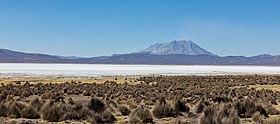Ubinas
| Ubinas | |
|---|---|

Ubinas volcano and Salinas lagoon, seen here in August 2015.
|
|
| Highest point | |
| Elevation | 5,672 m (18,609 ft) |
| Coordinates | 16°21′18″S 70°54′11″W / 16.35500°S 70.90306°WCoordinates: 16°21′18″S 70°54′11″W / 16.35500°S 70.90306°W |
| Geography | |
| Location | Moquegua Region, Peru |
| Parent range | CVZ, Andes |
| Geology | |
| Mountain type | Stratovolcano |
| Last eruption | March to August 2015 (ongoing) |
Ubinas is an active 5,672-metre (18,609 ft) stratovolcano in the Andes of southern Peru. Until 2006, this stratovolcano had not erupted for about 40 years.
Ubinas is located in southern Peru. The upper slopes of the volcano, composed primarily of andesitic lava flows, steepen to nearly 45 degrees. The steep-walled, 1.4 km (4,600 ft) wide and 150 m (490 ft) deep summit caldera contains an ash cone with a 500 m (1,600 ft)-wide funnel-shaped vent that is 200 m (660 ft) deep. Debris-avalanche deposits from the collapse of the SE flank of Ubinas extend 10 km (6.2 mi) from the volcano.
The volcano is a composite cone built on a high plateau formed from Oligocene-Miocene (Neogene) ignimbrites and intrusive rocks. Ubinas comprises two edifices that divide two major periods of its eruptive behaviour. The first is the lower volcano under 600 m (2,000 ft) high, known as Ubinas 1 (eruptive period >376 ka), which collapsed and formed a debris-avalanche deposit as far as 12 km (7.5 mi) downstream Rio Ubinas. This collapse was followed by an eruption of non-welded ignimbrites, ponding to a thickness of 150 m (490 ft) over 5 km (3.1 mi) from the summit, and in turn was covered by a 100 m (330 ft) thick ash/pumice deposit. Ubinas 1 is overlain by a steeper cone more than 900 m (3,000 ft) high, known as Ubinas 2 (eruptive period <376 ka). Ubinas 2 formed the summit caldera, with walls up to 300 m (980 ft) high that consist of hydrothermally altered lava flows and floored by a 20 m (66 ft) thick pile of lapilli and ash-fall layer. This morphology was created by frequent eruptions in the Late Holocene from the younger inner crater. The inner crater is under 200 m (660 ft) high and shows pervasive hydrothermal alteration and abundant fractures. Countless explosive events have taken place inside the summit caldera during the last 9.7 ky, and it has been suggested by Thouret et al. that the caldera be considered gravitationally unstable.
...
Wikipedia

